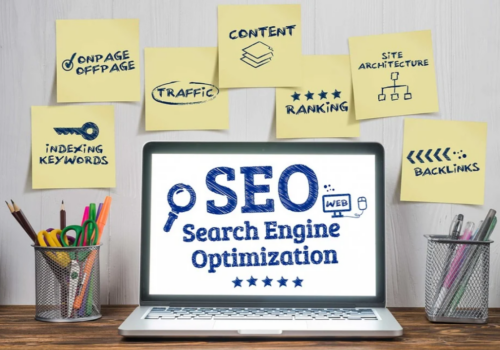In this article, we will discuss SEO Explained: A Step-by-step Guide to Search Engine Optimization
Despite the rising popularity of digital marketing, search engines are still the most convenient way to bring organic traffic to your website. Therefore, you must optimize your website for the various search engines if you want to get noticed online.
But how do you go about doing SEO the right way? What exactly are the goals of search engine optimization? What are the available tools that can help you go through the process? What are the types of SEO? What are the factors that can affect your SEO goals?
What are backlinks monitoring, and why is it crucial for your site’s rankings on Google and other search engines? And more importantly, how do you improve the accessibility of your website on such search engines? Read on to find your answers if you have any of these questions.
SEO Explained: What Is Search Engine Optimization?
Search Engine Optimization is a multi-stage process aimed at ranking a website or a web page at the top of the organic (non-paid) search engine results. In general terms, SEO is all about optimizing a website in such a way that a search engine such as Google or Yandex ranks it as the most relevant resource for a given topic or a keyword.
For example, we will consider a pharmacy business delivering medicines in a certain area. Now, whenever someone searches for anything related to medicine or health from within its operating area, the pharmacy website should come up as the first result. However, to achieve that rank, the pharmacy website will have to go through the whole process of Search Engine Optimization.
If the pharmacy doesn’t have a website optimized for the search engines, it will get a lousy index and might be listed on the 3rd or 4th page of search results despite the quality or relevance of its products.
What Are The Goals Of SEO?
SEO or Search Engine Optimization is used to achieve three primary goals, with the details being the following:
- To rank high on search engines: The first and foremost aim of SEO is to take the highest rank on Google search results for any given topic or keyword. The reason here is that 40% of Google users never go beyond the first page of search results, and, therefore, it is crucial to be among the top results to get the required traffic. Besides, the average click-through rate for the first result on Google is 34%. At the same time, the rest of the links share 68% of the clicks. Simply put, a quarter of the users searching for information never go beyond the first link. So, if you want a fair share of organic traffic from search engines, you have to be at the first spot, or as Grant Cardone’s book says, “If You’re Not First, You’re Last.”
- Provide better user experience: One of the key benefits of SEO is that it enables you to detect and prevent anything that might affect the users’ experience. Besides, Google SEO recommendations are all about delivering a better experience to the end user. It includes an easy-to-navigate website structure, lower loading times, transparency, easy access to required data, etc. So, if a website is said to be search engine optimized, it simply means it is suitable for the users.
- Bring in organic traffic: In the end, all efforts for SEO lead to a single destination, and that’s to bring high-quality organic traffic to the website. SEO is by far the best marketing tool to fetch traffic that actually matters. The truth is that a whole lot of online businesses spend millions to run ads on different marketing platforms such as Facebook and YouTube. If these companies were spending even half of their marketing budget on SEO, their sales could skyrocket. Why? Because it is easier to sell something when someone is actually looking or searching for it than randomly pitching your product to irrelevant customers.
SEO Explained: Best Tools for SEO In 2025
SEO is a vast field, and there are different scenarios where you will have to use various tools to get the required results. Here are 5 of the best tools for SEO:
Google Analytics
Google Analytics is by far the best and most free tool you can use for a better SEO strategy. It provides you with key insights that can help you make the required changes for a better rank on Google. The key feature of Google Analytics include:
- traffic analysis and visualization;
- campaign management and analysis;
- keywords analysis;
- user reports and analysis;
- errors reporting;
- sales and spending analysis.
Ahrefs
Ahrefs is another excellent tool for SEO engineers. It focuses more on on-page SEO as it lets you look for the most relevant keywords on any given topic. The critical feature of Ahrefs are as follows:
- keyword research;
- website audits;
- rank tracking;
- competition analysis;
Link Checker Pro
Backlinks are considered to be the “vote of confidence” by Google. In simple words, when different sites refer to your website, Google ranks it as a high authority website and, therefore, your rankings on Google search results increase. However, link building and backlink monitoring are hard fields to master. That is where the Link Checker Pro tool can prove to be of great help. It is an innovative, easy-to-use software that automates the whole backlink monitoring process. Key features of Link Checker Pro include the following:
- backlink monitoring;
- link building;
- batch analysis;
- website audits;
- Google rank analysis and recommendations.
Google Trends
Google Trends is an optimal asset for bloggers and news websites. It gives you a detailed outlook on the most popular trends and searches. You can track and write about the most relevant trends to achieve your traffic goals. These are the Google Trends features that can help you better your SEO:
- popular topics and trends;
- keyword analysis;
- search queries analysis and visualization;
- user demographics;
- local SEO optimization.
Screaming Frog
Screaming Frog is another SEO tool built to provide you with key insights through detailed SEO audits. The tool also provides you with a detailed analysis of competitors and the keywords they are using. It is known for its fast and robust approach to SEO with the following key features:
- error detection;
- competition analysis;
- website audits;
- duplicate content checker.
SEO Explained: A Step-by-step Approach to SEO
SEO should be in your utmost focus right from the planning stage of a website. Once a site goes public and is poorly ranked by Google, it is pretty hard to make it to the top. Therefore, all SEO must be done before the site is launched on the internet. Here is a step-by-step guide to SEO for a new website.
- Step 1 – Plan a trendy site: The first step is to plan your website according to the current trends. Make sure there is a need for what you are about to deliver. You can assess the feasibility through Google Trends.
- Step 2 – Select a domain: Next step would be to select a domain. Even though a domain name doesn’t directly affect your SEO scores, it still is crucial to get it right on the first try, as moving to a different domain name might affect your SEO. There are multiple things you should keep in mind while selecting a domain name, including:
- Use any top-level domain: .com, .org, .net, etc.
- Use small but catchy domains.
- Make sure to use the main keyword in your domain name, which conveys what your website is for.
- Avoid special symbols in the domain name.
- Step 3 – Design phase: Design isn’t something that will directly influence your SEO strategy, but a heavy design filled with images will increase your loading time which will directly affect your rankings on search engines. Therefore, it is better to use a nice and clean design with a minimalistic approach.
- Step 4 – Add necessary pages: Make sure your website has a privacy policy page, as it is crucial if you want to rank higher on Google. Your privacy policy should detail everything you want to collect from the user’s device, such as cookies, location, etc. Also, the About Us and Contact Us page is also essential.
- Step 5 – Find the keywords: Next step would be to find the most relevant keywords for your business. Remember, at this stage, you are looking for keywords relevant to your website and the idea it represents. If you have a blogging site, you must find keywords that are relevant to blogging.
- Step 6 – Get your content right: Now, it’s time to use the collected keywords to write content for your website. Use relevant keywords on the Homepage, About Us page, and Contact page. Use headings and subheadings to make it easier for the users to get the right information. You can use different tools to assess the competitors’ websites and plan your keywords strategy accordingly.
- Step 6 – Go online: After dealing with on-page SEO, it’s time to go online. At this stage, remember to submit your website to Google Search Console. Also, make sure to submit your Sitemap. Besides, get your site registered on Google Analytics to gain key insights on performance.
- Step 7– Website audit: Once the site is up and running, it’s crucial to run website audits to ensure that the site is performing well online. In simple words, it is the best time to go through the technical SEO processes to nail down the technical aspects such as loading time, navigation image size, etc.
- Step 8 – Off-page: Lastly, you will begin the tiring process of link building. Depending on the strategy you choose to work with, you place your backlinks on blogging websites, guest posts, start affiliate programs, or general directories such as Wikipedia and Quora.
Now, wait for your SEO strategies to work, as it will take some time before the effects of your efforts show any significant results.
In the meantime, you can start a blog on your website and start posting stuff related to your business with relevant keywords. For instance, if your website is selling paint, you will write blogs, such as the best paints for the doors, the most economical paint choice for farms, and the best outdoor paint options. You can then use internal links to the products you are selling online.
Quick Links:





